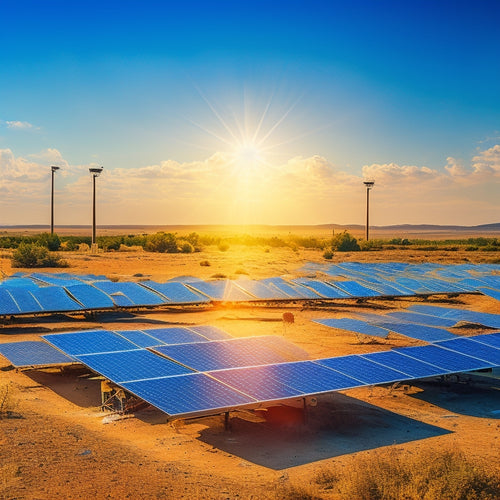Implementing Energy Storage Systems Step by Step
Share
To implement energy storage systems, start by evaluating your energy demands through thorough analysis and energy audits. Next, assess current consumption patterns and forecast future needs to align your storage solution effectively. Contemplate financial incentives that can lower initial investment costs, maximizing economic benefits. Incorporate advanced technologies for enhanced grid stability and durability. Guarantee the system ideally balances supply and demand by storing energy during low-demand periods and discharging during peaks. By following these structured steps, you'll enhance your energy management strategy and realize considerable long-term savings, all while considerably strengthening your energy independence. There's much more to reflect on.
At a Glance
- Conduct a thorough energy audit to assess current consumption patterns and identify peak usage times for effective planning.
- Analyze future energy needs using historical data and modeling tools to forecast seasonal demands and optimize storage system requirements.
- Evaluate available financial incentives and government programs to lower initial investment costs for energy storage systems.
- Choose the appropriate energy storage technology based on durability, performance metrics, and compatibility with renewable energy sources.
- Develop a strategic implementation plan that includes installation, integration with existing infrastructure, and ongoing maintenance for optimal performance.
Cost-Effective Energy Solution
When evaluating energy storage systems, understanding their economic benefits is essential for your decision-making process.
You'll find that analyzing long-term savings can reveal significant financial advantages over time. This assessment not only impacts your immediate costs but also shapes your overall energy strategy.
Economic Benefits Overview
Energy storage systems (ESS) present a cost-effective energy solution that can greatly enhance economic viability for both businesses and consumers. By integrating ESS into your energy strategy, you can capitalize on financial incentives provided by government programs and utilities. These incentives can considerably lower initial investment costs, making it easier for you to adopt advanced energy technologies.
In addition to reducing upfront expenses, ESS can improve your investment returns. The ability to store energy during low-demand periods and employ it when demand peaks allows you to minimize energy costs. This strategy not only stabilizes your energy expenses but also maximizes the value derived from renewable energy sources, ensuring you stay ahead in a competitive market.
Moreover, ESS can provide you with greater energy independence. By relying less on external energy suppliers, you mitigate the risks associated with fluctuating energy prices. This autonomy can lead to more predictable budgeting and financial planning, enhancing your overall economic stability.
To conclude, the economic benefits of energy storage systems are varied, encompassing reduced costs, financial incentives, and improved investment returns—all contributing to a more sustainable and profitable energy future for you.
Long-term Savings Analysis
Integrating energy storage systems into your energy strategy not only offers immediate economic benefits but also paves the way for significant long-term savings. By conducting a thorough investment analysis, you can identify the potential returns from your energy storage investments over time. These systems enable you to store energy when demand is low and release it during peak periods, effectively reducing your energy costs.
In terms of financial forecasting, it's essential to evaluate the lifecycle costs of your energy storage system. This includes initial capital expenses, maintenance, and potential incentives or rebates. When you compare these costs against the savings generated from reduced energy purchases and demand charges, the long-term financial benefits become apparent.
Moreover, energy storage can improve your energy resilience, mitigating risks associated with fluctuating energy prices and outages. By investing in such systems, you're not just securing immediate financial advantages; you're also positioning yourself for sustained savings and greater energy autonomy in the future.
Ultimately, the strategic implementation of energy storage aligns with your desire for freedom from unpredictable energy costs, making it a prudent choice for your energy structure.
Enhanced Grid Stability
Enhanced grid stability relies heavily on energy storage systems for effective frequency regulation and seamless integration of renewable energy sources.
These systems play a vital role in storing excess energy produced during peak sunlight hours, which can then be released during periods of high demand or low generation. By maintaining a consistent balance between supply and demand, these systems can mitigate fluctuations that may destabilize the grid.
You'll find that leveraging energy storage leads to a more resilient and reliable energy infrastructure, supporting high-quality solar battery integration for off-peak use and emergencies.
Frequency Regulation Benefits
Maintaining grid stability is essential for reliable electricity delivery, and frequency regulation plays a key role in achieving this. As you implement energy storage systems, consider how they can enhance frequency regulation by providing rapid response to fluctuations in supply and demand. By integrating these systems, you can effectively support ancillary services that help maintain the grid's operational balance.
Energy storage units act as a buffer, absorbing excess energy during low demand and releasing it during peak usage. This capability not only mitigates the risk of frequency deviations but also enhances the grid's overall resilience.
When paired with demand response strategies, energy storage can optimize performance, ensuring more efficient energy distribution and minimizing costs. Moreover, the ability of energy storage systems to deliver quick bursts of power or absorb energy helps stabilize grid frequency, which is critical for preventing outages and maintaining service quality.
Renewable Energy Integration
Energy storage systems play an essential role in facilitating the integration of renewable energy sources into the grid, ultimately contributing to enhanced grid stability. By effectively utilizing solar energy and wind power, these systems enable you to manage fluctuations in energy production and consumption. This energy management is fundamental for grid integration, ensuring that renewable sources can deliver consistent power despite their intermittent nature.
Advanced storage technologies, such as lithium-ion batteries and pumped hydro, enhance system efficiency and support demand response initiatives. By storing excess energy during peak production hours and discharging it during high demand, you can optimize the grid's performance.
Moreover, policy incentives are imperative in driving investments towards these storage solutions, allowing you to capitalize on market trends favoring sustainable energy. The environmental impact of integrating renewables with storage systems is significant, reducing reliance on fossil fuels and lowering carbon emissions.
As you investigate these pathways, remember that effective energy storage not only stabilizes the grid but also enables you to adopt a cleaner, more resilient energy future.
Key Advantages of Storage Systems
Energy storage systems offer significant cost savings potential by optimizing energy usage and reducing peak demand charges.
By utilizing renewable energy sources, these systems not only lower energy bills but also contribute to a reduction in carbon footprint and climate change impact by utilizing excess solar or wind energy renewable home energy storage systems.
Additionally, they enhance grid stability by providing backup power and balancing supply and demand in real-time.
Understanding these advantages is essential for maximizing the efficiency and reliability of energy systems.
Cost Savings Potential
When considering the implementation of storage systems, one of the most persuasive aspects is their cost savings potential. By strategically integrating these systems, you can greatly reduce energy expenses and enhance your financial returns.
Storage systems allow you to store energy during off-peak hours when rates are lower and use it during peak demand, minimizing costs.
Additionally, many regions offer incentive programs that provide financial support for energy storage installations. These programs can drastically lower your initial investment, further improving the viability of your project.
The combination of lower operational costs and these incentives can lead to impressive investment returns over the system's lifespan.
Furthermore, energy storage systems can create opportunities for revenue generation through demand response programs, allowing you to sell excess energy back to the grid during peak periods.
As you utilize these benefits, you'll not only increase your energy independence but also enable a more resilient financial future.
Enhanced Grid Stability
Storage systems play an essential role in improving grid stability, particularly in balancing supply and demand fluctuations. By integrating these systems, you can effectively manage intermittent renewable energy sources, such as solar and wind, which are often unpredictable. This capability is critical for implementing grid resilience strategies that guarantee a stable and reliable energy supply.
When you incorporate energy storage systems, you're not just improving energy reliability; you're also enabling rapid response to grid disturbances. These systems can discharge energy during peak demand periods, reducing the risk of blackouts and guaranteeing that your energy needs are met without interruption. This proactive approach greatly improves the overall stability of the grid.
Moreover, storage solutions can provide ancillary services, such as frequency regulation and voltage support, which are essential for maintaining grid health. By investing in these technologies, you're contributing to a more strong energy infrastructure that can adapt to changing conditions and consumer demands.
Assess Your Energy Demands
To effectively assess your energy demands, start by analyzing your current consumption patterns. This involves tracking usage data over time to identify peak periods and fluctuations.
Conducting a thorough energy needs assessment will provide understandings into your home's energy efficiency and help you pinpoint times of high and low usage.
Additionally, forecasting your future energy needs will guarantee that your energy storage system aligns with both present and anticipated requirements.
Analyze Current Consumption Patterns
Understanding your energy consumption patterns is essential for optimizing energy efficiency and identifying potential savings. By conducting energy audits, you can gain useful understandings into your current usage trends. This process involves a detailed examination of your energy bills, identifying peak usage times, and evaluating how different appliances contribute to your overall consumption.
Start by gathering historical energy data to pinpoint your highest usage periods. You'll want to categorize your energy consumption—determine which appliances or systems consume the most power and when. For example, you might notice that heating or cooling systems greatly impact your energy bills during specific months.
Next, analyze how your lifestyle influences energy use. Are there times when you could reduce your consumption without sacrificing comfort? By understanding these variations, you can adopt strategies that align with your energy goals.
Once you've mapped out your consumption patterns, you'll be better equipped to make informed decisions about energy storage systems. This analysis not only helps you maximize efficiency but also enables you to take control of your energy future, ultimately leading to cost savings and enhanced energy independence.
Forecast Future Energy Needs
Forecasting your future energy needs is crucial for effective planning and investment in energy storage systems. To accurately assess your energy demands, you'll need to engage in comprehensive demand forecasting and energy modeling. These processes help identify trends and variations in your energy usage, allowing you to predict how much energy you'll require in the future.
Start by analyzing historical data on your energy consumption. This data serves as the foundation for your demand forecasting. Look for patterns during different seasons, special events, or changes in operational capacity that could impact your energy needs.
Once you've identified these patterns, apply energy modeling techniques to simulate various scenarios, such as increased production, the adoption of new technologies, or shifts in consumer behavior.
Utilize software tools that can integrate different variables and provide you with a clearer visualization of your future energy environment.
Longer Lifespan Than Batteries
When you compare energy storage systems to traditional batteries, you'll notice significant differences in durability and performance.
These systems often feature advanced materials and technologies that enhance their lifespan, reducing the frequency of replacements.
As a result, investing in these alternatives can lead to lower long-term costs and improved reliability for your energy needs.
Enhanced Durability and Performance
In the domain of energy storage systems, enhanced durability and performance are crucial attributes that set advanced technologies apart from traditional batteries. When you investigate options, consider how these systems undergo rigorous durability testing, ensuring they withstand various environmental conditions and operational stresses.
Unlike conventional batteries that often degrade over time, advanced energy storage solutions can maintain their integrity through extensive cycles.
You'll find that performance metrics, such as charge and discharge rates, play a critical role in evaluating these systems. With higher efficiency and faster response times, they not only outlast traditional batteries but also provide consistent output when you need it. This reliability is fundamental for applications where energy availability directly impacts operational success.
Moreover, the materials used in state-of-the-art energy storage systems contribute greatly to their longevity. Innovations in design and chemistry allow for reduced wear and tear, further enhancing lifespan.
Frequently Asked Questions
What Types of Energy Storage Technologies Are Available?
You'll find various energy storage technologies, including advanced battery technologies like lithium-ion and flow batteries, and thermal storage systems that employ heat for energy. Each option offers unique benefits depending on your specific energy needs and applications.
How Do I Choose the Right Energy Storage System for My Needs?
To choose the right energy storage system, assess your battery capacity needs and prioritize energy efficiency. Analyze your energy consumption patterns and consider environmental factors to determine the ideal solution that grants you greater freedom and independence.
Are There Government Incentives for Energy Storage Installation?
When it rains, it pours; you'll find numerous government incentives for energy storage installation. Federal rebates and tax credits can greatly reduce your costs, enabling you to utilize energy freedom while enhancing your financial stability.
What Maintenance Is Required for Energy Storage Systems?
To guarantee system longevity, you'll need regular battery maintenance, including checking electrolyte levels, cleaning terminals, and monitoring performance. This proactive approach minimizes downtime and enhances overall efficiency, giving you the reliable energy storage you desire.
How Can Energy Storage Systems Integrate With Renewable Energy Sources?
You'll find that integrating energy storage systems with renewable sources creates extraordinary grid integration, enhancing renewable collaboration. It allows you to store excess energy, ensuring a reliable supply while maximizing the benefits of sustainable resources.
Explore More
Incorporating energy storage systems isn't just a technical upgrade; it's like planting a tree that grows stronger over time, providing shade and shelter for future generations. Just as a tree nurtures its environment, these systems enhance grid stability and reduce costs, ensuring your energy demands are met efficiently. By investing in these solutions, you're not just securing your energy future—you're cultivating a sustainable legacy that benefits both your community and the planet for years to come.
Related Posts
-

Best Solar Powered Flashlights for Emergency Situations
When you're choosing the best solar-powered flashlights for emergency situations, focus on their brightness, battery ...
-

What Happens Without a Charge Controller in Solar Panels
Without a charge controller in your solar panel system, you risk overheating batteries due to overcharging, which can...
-

Key Features of a DC to AC Converter
A DC to AC converter features high efficiency and conversion rates, which reduce energy costs and improve performance...


